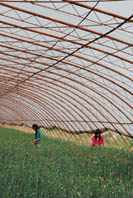|
Probing Characteristic Agriculture
|

|
|
A wind farm at the foot of the Helan Mountain. |
Zhongwei City in Ningxia is well known for its Chinese wolfberry production, which covers an area that exceeds 200,000 mu (1 mu equals 1/15 of a hectare). In 2008, the city's selenium-rich watermelons became nationally famous, and it was designated as a fruit supplier for the Beijing Olympics.
Zhongwei is located in the very center of Ningxia, and the locals used to suffer regularly from drought. Now, many places in Zhongwei grow watermelons on sand fields, and many people have grown rich.
For example, Wu Jinhua, 26, is a farmer from Beigang Village in Zhongning County. She takes care of her family's 20-mu watermelon field. "The soil was not suitable for growing watermelons, so sand was brought in from elsewhere," she says. Zhongwei began to popularize watermelon growing last year, and many villagers in Beigang earned a lot of money as a result. Wu started the crop this year, and the yields from her plot brought in RMB 10,000.
To fight drought, the local farmers invented innovative ways to retain moisture. They now place rocks on the field, and the melon plants get moisture from the dew that forms on the rocks. Wu Jinhua's husband drives a truck to transport goods for others, while she takes care of their two children, in addition to growing watermelons and several mu of corn.
Wu's new sand field was not as prolific as those that have produced one or two yields, so next year she expects her field to yield twice as much as this year. Watermelon merchants from Wuhan City, in Hubei Province, came to the village and bought watermelons from growers. Compared with ordinary watermelons, the price of selenium-rich watermelons was much higher, fetching at least RMB 0.5 per kilogram.
At first, the local government helped farmers look for purchasing merchants. Now, with the increasing fame of the melons, many merchants from Sichuan and Hubei seek out melon-growing farmers directly. Hai Sheng, the township's deputy head, says that his family has also grown a few hectares of watermelon. Ripening in an area with long hours of sunshine and a high temperature gradation between night and day, and grown without application of chemical fertilizer, Zhongwei watermelons are very popular with consumers. The watermelon sand fields of 20 townships in Zhongwei's 100-kilometer dry belt total 1 million mu, with sales totaling RMB 600 million.
In Shenlin Township, Longde County under Guyuan City, in southern Ningxia, vegetable sheds covered in plastic sheeting can be seen everywhere. Farmer Li Kaiqing, 53, from Qiping Village, picks peppers in his vegetable shed. He has four such sheds covering 0.6 mu of land, and each shed yields an income of RMB 1,000. He says that if he were to plant wheat, his total income would be RMB 400 at most. He says that the vegetable sheds were constructed by the government free-of-charge, and the pepper seedlings were also provided by the government at no cost. Currently, the four villages in Shenlin Township have built vegetable sheds covering more than 3,000 mu of land.
The cultivation method for improving the crop-growing environment using scientific-technological means is called "facility agriculture." Wang Zhengwei says that Ningxia's "facility agriculture" will cover one million mu of land, averaging one mu per household — a rarity in the country.
|
